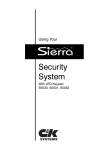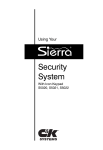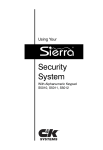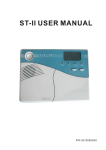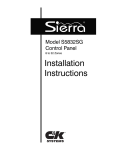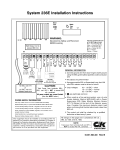Download Sierra S5030 LED Keypad End User Manual
Transcript
Using Your Security System With LED Keypad S5030, S5031, S5032 Contents 1 Overview Your Security System ....................................... 1 How Your Security System Works ................... 2 Your System's Programming ........................... 3 Getting Used to Your System ........................... 3 Quick Guide to Your Keypad ............................ 4 Understanding the Lights (LEDs ...................... 5 Emergency Keys .............................................. 6 2 User Codes and Privileges About User Codes and User Numbers ............ 7 How to Enter a User Code ............................... 7 How to Assign or Change User Codes ............ 8 How to Correct a User Code Entry ................ 10 How to Delete a User Code ........................... 10 Types of User Codes ...................................... 11 Master User Code .......................................... 11 Basic User Code ............................................ 11 Kidwatch Code ............................................... 12 Maid Code ...................................................... 14 Temporary Maid Code .................................... 15 Duress Code .................................................. 16 Relay Code ..................................................... 16 Selecting the Right User Number .................. 17 3 Arming and Bypassing How the Arming Modes Differ ........................ 18 Quick Arming Modes ...................................... 18 Exit Delay ....................................................... 19 Full Arming ..................................................... 19 Quick Full-Arming ........................................... 19 Home Arming ................................................. 20 Quick Home-Arming ....................................... 20 Instant Home-Arming ..................................... 21 Quick Instant Home-Arming ........................... 21 Automatic (Timed) Arming ............................. 22 Arming with Not-Ready Zones ....................... 23 Bypassing ....................................................... 24 Quick Bypassing ............................................ 25 Optional Arming Features .............................. 26 Canceling an Arming Sequence .................... 27 4 Disarming and Alarms Entry Delays ................................................... 28 Disarming ....................................................... 28 Automatic (Timed) Disarming ........................ 29 Canceling an Alarm ........................................ 30 After an Alarm ................................................ 30 How to Prevent False Alarms ........................ 31 Optional Alarm Features ................................ 32 5 System Settings How to Set the Calendar and Clock ............... 33 How to Turn the Warning Tone On/Off ........... 35 How to Turn the Chimes On/Off ..................... 35 How to Turn the Backlight On/Off .................. 36 How to Change the Relay 1 Days .................. 37 How to Change the Relay 2 Days .................. 38 How to Change the Relay 3 Days .................. 39 How to Change the Relay 4 Days .................. 39 6 System Maintenance How to Walk-Test the System ........................ 40 How to Use Event Memory ............................ 41 How to Test the Bells and Sirens ................... 44 To Start a Remote Programming Session .... 45 How to Test the Battery .................................. 46 Common System Messages .......................... 47 Troubleshooting Service Conditions .............. 48 7 Partitioning What Areas Do .............................................. 51 How Areas Affect User Codes ....................... 53 Pre-Assigned User Numbers ......................... 54 Changing Area User Codes ........................... 54 How Areas Affect the System ........................ 55 8 Notes System Configurations ................................... 56 Where to Place Smoke Detectors ................. 58 How to Evacuate in an Emergency ................ 59 Glossary of Terms .......................................... 61 Your Security System Smoke Detector ZONE ZONE Magnetic Contact Glassbreak Detector (Perimeter Protection) Keypad CONTROL PANEL ZONE Siren (Alarm) Monitoring Station Your security system includes a number of detection devices, such as magnetic contacts, glassbreak detectors, smoke detectors, and motion sensors. These devices identify alarm conditions and report them to the control panel. If programmed, the control panel sounds an alarm. The control panel also communicates with you (through the keypad) and with a monitoring station (through a telephone hook-up). Each region monitored by a sensor (or group of sensors) is known as a zone. Most zones will trigger an alarm only when the system is armed. Other sensors, such as smoke detectors, can trigger an alarm at any time. Your system's zones are identified on a label placed inside the door of your keypad. Monitoring station personnel respond to system messages, and notify emergency personnel as needed. A monitoring service is an optional part of a security system. 1 Overview 1 Motion Sensor (Interior Protection) Overview 1 How Your Security System Works When an intruder enters the building, a detection device is triggered. The device sends a message to the control panel. The device may have LEDs (lights) that flash. The control panel responds by sounding the alarm. (Alarm sounds vary. If your system is programmed for silent alarms, no bells sound.) A message is sent to the keypad and, if connected, to the monitoring station. The keypad blinks its LEDs. Personnel at the monitoring station confirm the alarm and respond accordingly. Some alarms can be canceled before the siren sounds and the monitoring station is notified. See Section 4 for more information. Siren Sounds Alarm CONTROL PANEL Keypad Issues Warnings Intruder Sensor Triggers Alarm Monitoring Station Is Notified 2 Your System's Programming Your Sierra security system has been customized to suit your needs. Besides selecting the best equipment for your building, your installer has programmed your system to operate in a way that reflects your lifestyle. For example, your system may be programmed to recognize special user codes, to arm and disarm automatically, or to report to a monitoring station. Throughout this manual, you will find descriptions of features that may have been programmed into your system. To see how your system was programmed, refer to the checklist in Section 8. Getting Used to Your System Your security system can be programmed for a learning period that can last from one to 31 days. With this option, you can practice using your system without causing any false alarms. Refer to Section 8 to see if this learning period was programmed into your system. During the learning period, your system does two things differently. First, during an alarm, you do not hear any sirens or bells. Second, if you have a monitoring station hook-up, your system does not notify the station of an alarm. After the learning period is over, your system automatically begins to function normally. If programmed, sirens and bells sound during an alarm, and the monitoring station receives information over the telephone hook-up. IMPORTANT: Your building is not fully protected from actual alarms during the learning period. 3 Overview 1 Overview 1 Quick Guide To Your Keypad The drawing below identifies and explains the important features of your LED keypad. Keypad Lights (LEDs) Describes the system's status, such as: —if the system is ready to arm —if an alarm has occurred —if a zone is faulted —other specialized information (See next page.) Numeric Keys Used to enter codes and perform other functions 4 Emergency Keys To notify your monitoring station of an emergency, press and hold these keys for two seconds until you hear an alarm. (Keys must be pre-programmed.) Secondary Function "Keys" Consists of the labels beneath the numeric keys. These keys allow you to change system settings. To activate, press and hold the numeric key above the label for two seconds until you hear two beeps. Understanding the Lights (LEDs) Your keypad has a number of LEDs that summarize the status of your security system. Each LED can convey several different messages by being on, off, or blinking. The illustration shows what messages the lights communicate. LED Blink Rates Slow: light blinks twice every three seconds Fast: light blinks three times every two seconds Uneven: light blinks for three seconds, then pauses for two seconds Power LED If on, the system's power supply is normal. If off, the keypad is drawing power from the battery. If blinking slowly, the battery is low (call for service). Ready LED If on, the system can be armed. If off, a problem exists which may prevent arming. Zone LEDs If off, the zone is normal. If on, a sensor in the zone detects a problem. (The zone is said to be faulted.) If blinking fast, a sensor in the zone is signaling an alarm, or the zone's sensor has been tampered with. If blinking slowly, the zone is bypassed. If blinking unevenly, a sensor in the zone may need service. (This is called a trouble zone.) Arm LED Service LED If on, the system is armed. If off, the system is disarmed. If on, a system If blinking fast, the system is about component is to arm; leave the building. malfunctioning and If blinking slowly, you have time to may need service. cancel an alarm, before it If off, all system sounds. components are If blinking unevenly, system is normal. armed with instant arming. If all of the LEDs are blinking, enter your user code. 5 Overview 1 Overview 1 Emergency Keys Your keypad is equipped with three emergency keys. The keys do not function unless your installer activated them. If activated, these keys are a one-button way to inform your monitoring station of a medical emergency, a fire, or a crime in progress. Depending upon how your system is programmed, an alarm may sound when an emergency key is pressed. To cancel the alarm, press the key and enter your user code. 6 To Use Emergency Keys: 1. To report a medical emergency, press and hold the key for 2 seconds. 2. To report a fire, press and hold the key for 2 seconds. 3. To report a crime in progress, press and hold the key for 2 seconds. You can assign a different user code and user number to each person who operates the system. Your security system supports up to 60 users. 2 If you prefer, you can assign only one user code and user number to a group of users. This is not recommended, since it will then be impossible to determine which individual gave a specific command. User Codes About User Codes and User Numbers A user code is a secret four-digit number, used to arm and disarm the system, and possibly to make other changes. You cannot assign the same user code to more than one user number. It is important to remember your user code, and to keep it secret. Every individual who has a user code is also assigned a two-digit user number. When you change or delete a user code, you are asked for the user number. How to Enter a User Code To enter a user code, simply press the four numbers in succession. Do not pause for more than five seconds between numbers. 7 How to Assign or Change User Codes User Codes 2 User codes can be created or changed as often as you like. Any code you select must be four digits long. You cannot use 0000, or assign the same code to more than one user number. Avoid codes that are easy to guess, like 1234. The default master user code (user number 1) is 5832. For security reasons, be sure to change this code to a different number. Do not assign the code 5832 to another user. To Assign or Change a User Code: 1. [user prg] key for 2 seconds until you hear two beeps. 2. Be sure to record the user codes, and keep these records in a safe place. 8 Enter the master user code. Next, enter the 2-digit user number you wish to change. To determine the next available user number, key. press the Your LED keypad does not display the user code assigned to a user number. However, if your system has an alphanumeric or icon keypad, you can use these keypads to view the user codes which have been assigned to the system's users. If you make a mistake while assigning a user code, you may correct it by repeating the procedure. Press and hold the The zone LEDs light to identify the next available user number. Compare the pattern of lit zone LEDs to the chart on the next page to determine the user number. 3. Enter the new 4-digit user code. The display changes to indicate the next available user number. 4. To exit, press and hold the key for 2 seconds. When you are changing a user code, the zone LEDs light to identify which two-digit user number you have selected. Match your keypad's LED pattern to the charts below to identify the user number. Lit LED Pattern No. Lit LED Pattern User Codes No. 2 9 How to Correct a User Code Entry User Codes 2 You will know that you entered an incorrect code when the system does not complete your command. As a security feature, your keypad does not beep when you enter an incorrect user code. If you make a mistake entering the user code, simply re-enter the code. To Correct a User Code Entry: 1. Re-enter code. How to Delete a User Code You may delete a code by changing that code to 0000. Follow the procedure for assigning or changing a user code. To Delete a User Code: 1. Change the user code to 0000, following the procedure for assigning or changing a user code. TIP 10 Some security systems include wireless keyfobs and remotes, used to arm and disarm the system. If a keyfob or remote is lost, you can protect your building by deleting its assigned user code. Types of User Codes Standard Code _X_ Optional Code ___ Active Certain Days/Times ___ Items on this checklist followed by an "X" are features of the user code. Master User Code Standard Code _X_ Optional Code ___ Active Certain Days/Times ___ The master user can arm and disarm the system, and can make other changes, such as disabling your system's features, and changing user codes. Basic User Code Standard Code _X_ Optional Code ___ Active Certain Days/Times ___ Depending upon how your system was programmed, basic users may have rights to arm, disarm, or bypass zones. 11 2 User Codes This section identifies the types of user codes your system may recognize. At the top of each user code section, you will see a checklist like this: Kidwatch Code User Codes 2 Designed for parents whose children come home first, this option allows you to be notified if your child is not home by a certain time. You can be notified by pager, by an automated telephone call, or by your monitoring station. (Not all monitoring stations offer this service.) Standard Code ___ Optional Code _X_ Active Certain Days/Times _X_ To Change Kidwatch Days : 1. Press and hold the [kidwatch] key for 2 seconds until you hear two beeps. All of the zone LEDs blink. 2. Enter the master user code. The zone LEDs of your key- The Kidwatch Code is a fourdigit code that you can change or delete like any other user code. The code is assigned to user number 11. It allows your children to disarm the system, and can be programmed to allow them to arm or bypass zones. How it works. After arriving home on a day when Kidwatch is active, your children disarm the system by entering the Kidwatch Code. If they do not enter the code by a given time, you are notified. pad light to show which days of the week Kidwatch is active. The zone 1 LED stands for Sunday; zone 2, for Monday, and so on. If the LED is lit, the use of the Kidwatch Code is monitored on that day. 3. to switch on or off. The appropriate LED turns on or off, to reflect the change. 4. (continued) 12 Press the corresponding number of the day you wish To exit, press the key. Reviewing Kidwatch Use. You can review the times that Kidwatch Codes were used to arm and disarm your system by viewing Event Memory. See Section 6 for more information. Turning Kidwatch On and Off. Kidwatch can be turned on and off. When Kidwatch is turned off, you are no longer notified of the use of the Kidwatch Code. Otherwise, the Kidwatch Code works as before. If you turn Kidwatch on or off, it remains that way until you change it back. To Turn Kidwatch On/Off: 1. Press and hold the [kidwatch] key for 2 seconds 2 until you hear two beeps. 2. Enter the master user code. If Kidwatch is turned on, the zone 8 LED is on. If Kidwatch is turned off, the zone 8 LED is off. 3. Press the key to turn Kidwatch on or off. 4. To exit, press the key. Kidwatch Setup. See Section 8 for the specifics of how the Kidwatch Code was set up on your system. 13 User Codes Changing Kidwatch Days. You have the option of changing which days Kidwatch is in effect. To do so, follow the procedure on the previous page. Maid Code User Codes 2 Unlike other user codes, which work any day of the week, the Maid Code works only on certain days of the week. Standard Code ___ Optional Code _X_ Active Certain Days/Times _X_ To Change Maid Days: 1. Press and hold the [maid] key for 2 seconds until you hear two beeps. All The Maid Code is a four-digit user code that you can change or delete like any other user code. Your installer must have programmed your system to accept a Maid Code. For systems without multiple areas (as described in Section 7), the code is assigned to user number 13. It allows an individual to arm and disarm the system on specific days. How it works. Arriving at the building during a day when the Maid Code is active, the maid can disarm the system by entering the Maid Code. Upon leaving the building, the maid can arm the system by entering the same code. For the specifics of how the Maid Code was set up on your system, see Section 8. 14 of the zone LEDs blink. 2. Enter the master user code. The zone LEDs of your keypad light to show which days of the week the Maid Code is active. The zone 1 LED stands for Sunday; zone 2, for Monday, and so on. If the LED is lit, the code works that day. 3. Press the corresponding number of the day(s) you wish to switch on or off. The appropriate LED turns on or off, to reflect the change. 4. To exit, press the key. As the preceding section shows, the Maid Code can be programmed to work on certain days of the week only. If you prefer, however, you can set the Maid Code to work for the next few hours, regardless of the day of the week. The number of hours the Maid Code works depends upon your system's programming. Standard Code ___ Optional Code _X_ Active Certain Days/Times _X_ To Start the Maid Code Timer: 1. [maid] key for 2 seconds until you hear two beeps. All of the zone LEDs blink. 2. 3. The Temporary Maid Code, like the Maid Code, is assigned to user number 13. Enter the master user code. Press the key until the Zone 8 LED lights. 4. See Section 8 for the specifics of how your system was programmed. Press and hold the To exit, press the key. The Maid Code will now work for the next few hours. 15 2 User Codes Temporary Maid Code Duress Code User Codes 2 If an intruder forces you to disarm your system, this optional code sends a silent signal to alert monitoring station personnel that you are in danger. For systems without multiple areas (as described in Section 7), the duress code is assigned to user number 15. You can change or delete this code like any other user code. Relay Code Standard Code ___ Optional Code _X_ Active Certain Days/Times _X_ To Use the Duress Code: 1. Enter the four-digit code. Your system appears to disarm normally. However, a message is sent to your monitoring station that you are in danger. Standard Code ___ Optional Code _X_ Active Certain Days/Times ___ A relay code acts like a switch. When you enter this code, a device that is connected to the control panel is turned on or off. For example, your system can be programmed to switch the exterior lights of your building on or off when you enter a relay code. Relay codes must be programmed into your system by the installer. The relay code is a four-digit code that you can change or delete like any other user code. If you delete the relay code, you will no longer be able to use this feature. For systems without multiple areas (as described in Section 7), the relay code is assigned to user number 14. 16 Selecting the Right User Number 17 2 User Codes At installation, each user number is assigned rights and privileges. For example, user number 18 may have the right to arm, disarm, and bypass zones. This is true even if, in this example, there is no user 18 using the system. Thus, when you assign a user code to a new user, be sure that you select a user number with the privileges you want that user to have. Your installer should have provided you with specific information about how your system was configured. Refer to this information to select the proper user number. How the Arming Modes Differ 3 Full Arming. You cannot be inside the building when it is armed with full-arming. If sensors detect movement within a building, or at the building's perimeter, an alarm sounds. Arm/Bypass Your security system can be armed in a number of ways, to suit different situations. These modes are summarized below. Home Arming (optional): You can be inside the building when it is armed with home-arming. If someone enters the building through a protected door, you must enter a user code, or an alarm sounds. Instant Home-Arming (optional). You can be inside the building when it is armed with instant home-arming. If someone enters the building through a protected door, an alarm sounds instantly. Automatic Arming (optional). Your system can be pre-programmed to arm and disarm at preset times and days. You cannot be inside the building when it is automatically armed. (See Note 1 on page 62.) Quick Arming Modes If your system is programmed for quick arming, you do not need to enter your user code before arming begins. Refer to Section 8 to determine if your system was programmed for quick arming. Quick arming does not affect how your system behaves once it is armed. For example, there is no difference in the way a system armed with home-arming or quick home-arming protects you. 18 Exit Delay An exit delay is the amount of time you have to exit and secure the building, once your security system begins to arm. These delays last from 20 to 255 seconds, depending upon how your system was programmed. Interior armed Perimeter armed Exit allowed Requires user code Automatically arms No entry allowed Full Arming When your system is armed with full arming, both the perimeter and interior zones are armed. You are allowed a specific time to enter or exit the building before an alarm sounds. See Section 8 for the entry and exit delay settings programmed into your system. Quick Full-Arming. If your system is programmed for quick fullarming, you do not need to enter a user code. _X_ _X_ _X_ _X_ ___ ___ To Arm the System with Full Arming: 1. Make sure the Ready LED is lit. Enter your user code. Exit and secure the building. To Arm the System with Quick Full-Arming: 1. Press and hold the [quick exit] key for 2 seconds until you hear two beeps. Exit the building. 19 3 Arm/Bypass During the exit delay, the Arm LED blinks. The keypad may beep; if so, it beeps faster during the last ten seconds. If any zones are faulted (not ready to be armed), the corresponding zone LED lights and the Ready LED is off. Interior armed Perimeter armed Exit allowed Requires user code Automatically arms No entry allowed Home Arming Arm/Bypass 3 With home arming, you can remain inside a building while its perimeter sensors (such as doors and windows) are armed. No alarm sounds if a sensor detects movement within the building. To Home Arm the System: 1. Make sure the Ready LED is lit. 2. Press the key and en- ter your user code. If your system is programmed with Your system might be programmed for a home arming exit delay option. This means that one or more individuals can leave the building during the exit delay. Quick Home-Arming. If your system is programmed for quick home-arming, you do not need to enter a user code. ___ _X_ _X_ _X_ ___ ___ an exit delay, you can now leave. While the system is home-armed, the Arm LED is lit, and the interior LEDs blink. To Arm the System with Quick Home-Arming: 1. Make sure the Ready LED is lit. 2. Press the key. If your system is programmed with an exit delay, you can now leave. 20 With instant home-arming, an alarm sounds the instant a sensor on the building's perimeter detects a problem. The interior sensors are not armed. Before anyone can open a door or window, the system must first be disarmed. ___ _X_ ___ _X_ ___ _X_ To Arm the System with Instant Home-Arming: 1. 3 Make sure the Ready LED is lit. 2. Enter your user code, and press and hold the [instant] key for 2 seconds until you hear two beeps. The To prevent false alarms, use instant home-arming only when you are sure no system user will open a protected door or window. keypad beeps twice. The Arm LED and the interior zone LEDs blink. Your system is immediately instant home-armed. Quick Instant HomeArming. If your system is programmed for quick instant home-arming, you do not need to enter a user code. To Arm the System with Quick Instant Home-Arming: 1. Press and hold the [instant] key for 2 seconds until you hear two beeps. Your system is immediately instant home-armed. 21 Arm/Bypass Interior armed Perimeter armed Exit allowed Requires user code Automatically arms No entry allowed Instant Home-Arming Automatic (Timed) Arming Arm/Bypass 3 Your system can automatically arm itself at preset times of the day. At two minutes and again at one minute before the Automatic Arming sequence begins, the siren sounds. Then, the exit delay begins. You must leave the building during the exit delay, or an alarm sounds. You can postpone the Automatic Arming sequence by one hour. When the siren sounds two minutes before arming occurs, press the key, then enter your user code. You can change the days that Automatic Arming occurs by following the procedure to the right. To stop Automatic Arming, turn off all of the Automatic Arming days. To change the times that arming occurs, contact your installer. (See Note 1 on page 62.) 22 Interior armed _X_ Perimeter armed _X_ Exit allowed _X_ Requires user code ___ Automatically arms _X_ No entry allowed ___ To Change Automatic Arming Days: 1. Press and hold the [walk test] key for 2 seconds until you hear two beeps. Enter the master user code. 2. Press the key six times until you see the following: 1 2 3 4 5 6 7 8 3. Press the key. The zone LEDs light to indicate the days when Automatic Arming occurs. The zone 1 LED represents Sunday, etc. A lit LED means arming occurs on that day. 4. Press the number of the day(s) you wish to switch on or off. To exit, press the key. Arming With Not-Ready Zones Your system has been programmed to automatically handle notready zones in one of three ways described below. Refer to Section 8 to see how your system was programmed. Force Arming. With Force Arming, your system arms, even if some not-ready zones exist. All not-ready zones are ignored (bypassed), and therefore, not protected. Exception: Not-ready Day Buzzer or Day Bell zones must be manually bypassed before arming can occur. These are zones that cause a buzzer or bell to sound if they are faulted while the system is disarmed. (See Note 1 on page 62.) Chirp-Alert Arming. With Chirp Alert Arming, your system does not arm if a not-ready zone exists. At the end of the exit delay, your system's sounders chirp. You must re-enter the building and enter a user code, or an alarm sounds. Then, you must either correct or manually bypass these zones before the system can be armed. Goof-Proof Arming. With Goof-Proof Arming, the system does not arm if there are any not-ready exit zones (doors). Instead, an alarm sounds at the end of the exit delay. You must re-enter the building and correct the not-ready zones before arming can occur. 23 3 Arm/Bypass The zones in your system are not always ready to arm. For example, a zone would not be ready to arm if one of its sensors has been vandalized, needs service, or detects a potential alarm condition. Zones which are not ready to arm are referred to as not-ready zones. Bypassing Arm/Bypass 3 When you manually bypass a zone, the security system functions as if that zone does not exist. Bypassed zones are not protected. The master user can bypass any zone which is programmed for bypassing. Other users may have limited rights to bypass zones, depending on your system's programming. Restoring bypassed zones. If you manually bypass a 24-hour zone, such as a smoke detector, that zone remains bypassed until you restore it. However, if you manually bypass a zone which is not a 24hour zone, that zone is restored when you disarm the system. To Bypass a Zone: 1. When a zone is faulted, the zone's LED is lit. To bypass the zone, press the key. All of the LEDs are off. 2. Enter the two-digit zone number. (For zones 1-9, enter a "0" first.) The LED of the bypassed zone blinks. If the zone can- not be bypassed, you hear a 3-second error tone. 3. Enter your user code. The zone's LED blinks. To Restore a Bypassed Zone: 1. Repeat the procedure above. The zone operates normally. 24 Quick Bypassing To Bypass a Zone with Quick Bypassing: 1. 3 When a zone is faulted, the zone's LED is lit. To bypass the zone, press the With quick bypassing, any user can bypass any bypassable zone. key. Enter the two-digit zone number. For zones 1-9, enter a "0" first. IMPORTANT: If your system is programmed for quick bypassing, anyone can bypass your system's zones. Since bypassed zones are not protected, this feature increases the likelihood that your system may be defeated. (See Note 1 on page 62.) The keypad beeps twice. The zone's LED blinks. To Restore a Bypassed Zone with Quick Bypassing: 1. Follow the above procedure to manually bypass a zone. The zone operates normally. 25 Arm/Bypass Quick bypassing allows you to bypass zones without entering a user code. This option must be programmed into your system by the installer. Optional Arming Features Your system offers several optional arming features, described below. Refer to Section 8 to see which features are installed on your system. Arm/Bypass 3 Extended Exit Delay. This feature automatically resets the exit delay if you re-enter the building while the system is being armed. You may re-enter up to four times; each time, the exit delay is reset to its full value. Keypad Lockout. Designed to prevent an intruder from guessing a user code, this option causes the system to slow down if a series of invalid user codes are entered. Before a new code can be entered, the user must wait through a delay. The delay lengthens as more invalid codes are entered. Depending upon your system's programming, the keypad lockout may not affect arming. Keyswitch Arming. This accessory (Sierra S5051 or equivalent) allows you to arm and/or disarm the system with a key. Follow the instructions provided with the switch. Quick Exit. This option allows you to exit a home-armed building without disarming and re-arming. To start the exit delay, press and hold the [quick exit] key for 2 seconds until you hear two beeps. Then, enter your user code, and exit. (Depending upon your system's programming, you may not need to enter your user code.) Exit Termination. This option allows you to shorten the exit delay to the last five seconds by pressing a button connected to your keypad. 26 Optional Arming Features (continued) Canceling an Arming Sequence Any arming command with an exit delay may be canceled before the system is armed. To cancel an arming sequence, enter your user code during the exit delay. To Cancel an Arming Sequence: 1. Enter your user code. 27 3 Arm/Bypass Automatic Home-Arming. Automatic Home-Arming allows you to remain inside a building while its perimeter sensors (such as doors and windows) are armed. Arming begins by entering your user code. If you exit the building during the exit delay, the system arms both the interior and perimeter zones (full arming). However, if you do not exit the building, the system automatically arms the perimeter zones only (home arming). Entry Delays Similar to an exit delay, an entry delay is the time you are allowed to enter the building, walk to the keypad, and enter a user code before an alarm sounds. This delay lasts from 10 to 255 seconds, depending upon your system's programming. The length of the delay may differ, depending on which door you use. Disarm/Alarms 4 During the entry delay, the Arm LED blinks. The keypad may beep during the delay. If so, it buzzes during the last ten seconds. Disarming Regardless of which method was used to arm your system, the disarming sequence is always the same. Be sure that the door you use to enter the building has been programmed with an entry delay. 28 To Disarm the System: 1. Enter through a door programmed with an entry delay. 2. Enter your user code. Automatic (Timed) Disarming To Change AutomaticDisarming Days: 1. Press and hold the [walk test] key for 2 seconds until you hear two beeps. You can change the days that Automatic Disarming occurs by following the procedure to the right. To stop Automatic Disarming, turn off all of the Automatic Disarming Days. To change the times that Automatic Disarming occurs, contact your installer. (See Note 1 on page 62.) Enter the master user code. 2. Press the key seven times until you see the following: 1 2 3 4 5 6 7 8 3. Press the key. The zone LEDs light to indicate when Automatic Disarming occurs. The zone 1 LED represents Sunday, etc. A lit LED means disarming occurs on that day. 4. Press the number of the day(s) you wish to switch on or off. To exit, press the key. 29 4 Disarm/Alarms Your system can automatically disarm itself at preset times of the day. This option must be programmed into your system by your installer. Interior armed _X_ Perimeter armed _X_ Exit allowed _X_ Requires user code _X_ Automatically arms _X_ No entry allowed ___ Canceling an Alarm If programmed, your system pauses briefly before sounding an alarm. This gives you the opportunity to cancel a false alarm. You can cancel the alarms of any sensor, including a smoke detector. Disarm/Alarms 4 To Cancel an Alarm: 1. The Arm LED blinks and your system's sirens may sound. Press the key and enter your user code. The Zone LED blinks to in- The amount of time you have to cancel the alarm depends upon how your installer programmed the system. See the "Cancel Alarm Time" listing in Section 8. Your keypad may beep to warn you that an alarm is about to occur. dicate an alarm occurred. To clear the display, follow the instructions below. Five seconds after an alarm is canceled, your system reverts to normal. After an Alarm You should reset your system after an alarm. This action clears your keypad's display and resets your sensors. To Reset After an Alarm: 1. Press and hold the key for 2 seconds until you hear two beeps. 30 How to Prevent False Alarms False alarms are more than a nuisance—they reduce the reliability of your security system. Here are a few steps you can take to prevent the annoyance and expense of false alarms. 1. Know your system. Make sure all system users understand how to arm and disarm, and what special functions they can and cannot do. 3. If you have an optional keyswitch, be sure you know where your keys are. 4. Shut doors and windows completely. Before arming the system, be sure all protected windows and doors are closed. As you leave the building, shut the exit door completely. 5. Regularly test and maintain your system. Routine testing and maintenance will help you detect a system malfunction early. See Section 6 for more information. 6. Be selective when arming the system for instant alarms. This setting should not be used when a user might open a door or window. 7. Keep pets (and other animals) from motion and infrared sensors. If you have obtained a pet since your security system was installed, your system may need to be modified. Contact your dealer for more information. 31 4 Disarm/Alarms 2. Remember your user code. Forgotten user codes are the most common cause of false alarms. How to Prevent False Alarms (continued) 8. Bypass trouble zones. If you have one or more trouble zones (zones with sensors that may need service), bypass them before arming your system. Have the sensor(s) inspected if the problem continues. Remember that bypassed zones are not protected. 9. Make sure your system clock and calendar are accurate. Many system functions, such as Kidwatch and Automatic Arming, are time-related. Be sure to adjust your clock to reflect seasonal time changes (such as Daylight Savings Time). Also, check your system's clock and calendar after a power failure. See Section 5 for more information. Disarm/Alarms 4 Optional Alarm Features Your system offers additional optional alarm features, described below. Refer to Section 8 to see which of these options are installed on your system. Alarm Lockout. The system automatically ignores a sensor that repeatedly sends alarm signals. Silent alarm. With this option, no bells or sirens sound during an alarm, but the monitoring station is notified. If the phone lines are down, or the monitoring station cannot be reached for some other reason, the on-site bells or sirens may be reactivated, depending upon how the system is programmed. 32 How to Set the Calendar and Clock NOTE: Your LED keypad does not display the current date and time. Therefore, when you set the date and time, be sure to enter the numbers carefully. To Set the Calendar and Clock: 1. Press and hold the [clock] key for 2 seconds until you hear two beeps. Enter the master user code. 2. The zone 1 LED lights. (Some of the LEDs in the second row of Zone LEDs may pay attention to these lights.) Reset the calendar and clock after seasonal time changes, such as Daylight Savings Time. Also, even if your system has a backup battery, it is best to check the calendar and clock following a power failure. Enter the day of the month, using two numbers. When key. done, press the 3. The zone 2 LED lights. Enter the number of the month, using two numbers. (Enter NOTE: your system's clock uses a 24-hour, or militarystyle, format. For example, in a 24-hour format, 1:00 p.m. is expressed as 13:00. When you enter the hours of the day, be sure to use this format. (In 24-hour time, midnight is 00:00 and noon is 12:00.) 5 also light; you do not need to "01" for January, etc.) When key. done, press the 4. The zone 3 LED lights. Enter the number of the year, using two numbers. (Enter "98" for 1998, etc.) When done, press the key. 33 Settings If your system's calendar or clock is incorrect, it could result in false alarms. Since many system functions are time-dependent, it is important to regularly adjust your system's calendar and clock. Calendar and Clock (continued) To convert from 24-hour time to 12-hour time, subtract 12 hours from all times greater than 12:00; these are p.m. times. 5. The Zone 4 LED lights. Enter the hour of the day, using two numbers. Be sure to use a 24-hour format (see the note. When done, press the key. 6. The zone 5 LED lights. Enter the minutes past the hour, 5 using two numbers. When Settings done, press the key. The system returns to its normal mode. 34 How to Turn the Warning Tone On/Off To Turn Tone On/Off: 1. Press and hold the [pre-warn] key for 2 seconds until you hear two beeps. All of the LEDs blink. 2. You can turn the tone on or off by following the instructions to the right. If the tone is on, the action turns it off. If the tone is off, the action turns it on. Enter the master user code. If you hear three beeps, the tone is now on. If you hear one continuous 3-second beep, the tone is now off. How to Turn the Chimes On/Off When your system is set to chime, you hear three beeps whenever you enter a protected door or window. You can turn the chimes on or off by following the instructions to the right. If the chimes are on, this action turns them off. 5 Settings You hear a beeping sound when the system is about to arm, disarm, or sound an alarm. The warning tone reminds you that time remains to cancel the arming or disarming sequence, or to cancel the alarm. To Turn Chime On/Off: 1. Press and hold the [chime] key for 2 seconds until you hear two beeps. All of the LEDs blink. 2. Enter the master user code. If you hear three beeps, the tone is now on. If you hear one continuous 3-second beep, the tone is now off. 35 How to Turn the Backlight On/Off Whenever you use your keypad, a light automatically illuminates the keys. This backlight shuts off 60 seconds after you have finished using the keypad. To Turn Backlight On/Off: 1. Press and hold the [walk test] key for 2 seconds until you hear two beeps. Enter the master user code. 5 If you wish, you can set the backlight to shine continuously. If you turn the backlight on, you can turn it off again by repeating the procedure to the right. The zone 8 LED lights. 2. key five Press the times until you see the following pattern of lit zone Settings LEDs: 1 2 3 4 5 6 7 8 3. Press the key. If you hear three beeps, the backlight is now on. If you hear one continuous 3-second beep, the backlighting is now off. 4. To exit, press the key. 36 How to Change the Relay 1 Days The relays are programmed to turn on or off one or more devices which are connected to your system's control panel. You can change the days that Relay 1 works by following the procedure to the right. To change the days that Relays 2, 3, and 4 work, see the following pages. For example, a business may use a relay to turn on the floodlights near its loading docks automatically. By using the relay schedule menu, the business owner could turn the lights off during the business' upcoming holiday. To Change the Relay 1 Days: 1. Press and hold the [walk test] key for 2 seconds until you hear two beeps. Enter the master user code. The Zone 8 LED lights. Press the key eight times until you see the following pattern of lit zone 1 2 3 4 5 6 7 8 2. Press the key. The zone LEDs of your keypad light to show when the relay is active. The zone 1 LED represents Sunday; the zone 2 LED represents Monday, etc. If the LED of a particular day is lit, that means that the relay works on that day. To change the time of day that the relays work, contact your installer. 5 LEDs: Press the corresponding numbers of the day(s) you wish to switch on or off. The (continued) 37 Settings Your system can be programmed with up to four relays that work on the days of the week you specify. The relays are numbered 1, 2, 3, and 4. Changing Relay 1 Days (continued) To Change the Relay 1 Days (continued): appropriate LED should turn on or off, to reflect the change. 3. To exit, press the key. Settings 5 How to Change the Relay 2 Days To change the Relay 2 days, follow the procedure to the right. To Change the Relay 2 Days: 1. Press and hold the [walk test] key for 2 seconds until you hear two beeps. Enter the master user code. Press the key nine times until you see: 1 2 3 4 5 6 7 8 2. Follow steps 2 and 3 for changing the Relay 1 Days. 38 How to Change the Relay 3 Days To change the Relay 3 days, follow the procedure to the right. To Change the Relay 3 Days: 1. Press and hold the [walk test] key for 2 seconds until you hear a beep. Enter the master user code. Press key ten times the until you see: 1 2 3 4 5 6 7 8 Follow steps 2 and 3 for changing the Relay 1 Days. How to Change the Relay 4 Days To change the Relay 4 days, follow the procedure to the right. To Change the Relay 4 Days: 1. Press and hold the [walk test] key for 2 seconds until you hear two beeps. Enter the master user code. Press the key 11 times until you see: 1 2 3 4 5 6 7 8 2. Follow steps 2 and 3 for changing the Relay 1 Days. 39 Settings 2. 5 How to Walk-Test the System A walk-test allows you to test your system's functions without causing an alarm. You should conduct a walk-test once a week. Maintenance 6 The first step of a walk-test is to place your system in walktest mode. Then, walk in front of motion sensors, and open protected doors and windows. Each time a sensor detects your presence, the keypad beeps, and lights the LED of the most recently faulted zone in its display. To Conduct a Walk-Test: 1. Press and hold the [walk test] key for 2 seconds until you hear two beeps. Enter the master user code. You see the following pattern of lit zone LEDs: 1 2 3 4 5 6 7 8 2. Press the key. 3. Test your sensors by opening protected doors and windows, and by walking in front If your system fails to detect a sensor, exit the walk-test mode and make sure the sensor's zone is not bypassed. (The LED of a bypassed zone blinks slowly.) If the zone is bypassed, remove the bypass and repeat the walk-test. If your system still fails to detect the sensor, contact your service representative. IMPORTANT: during a walktest, your building is not protected against actual alarms. 40 of motion sensors. The keypad beeps twice each time you open and close a protected door or window, or a motion detector senses your presence. The affected zone LED lights. 4. When done, press the key. How to Use Event Memory To Review Event Memory: 1. [walk test] key for 2 seconds until you hear two beeps. Enter the master user code. 2. Within Event Memory, your keypad's zone LEDs light in patterns to identify different events. The table on the next pages shows the various patterns the keypad uses. Press and hold the key until Press the you see the following pattern of lit zone LEDs: 1 2 3 4 5 6 7 8 3. 4. Press the 6 key. To view the oldest events . To view first, press the latest events first, press . The keypad beeps twice. For the next 15 seconds, the zone LEDs display the earliest or latest event. 5. Press to view the next event, or to view the previous event. 6. To exit, press the key . 41 Maintenance Your system records important events, such as alarms, in Event Memory. You can review Event Memory to monitor the status of your system. As many as 500 events may be recorded, depending upon your system's configuration. Lit Zone LEDs Maintenance 6 Meaning 12345678 12345678 12345678 12345678 12345678 An alarm occurred. A system device was deliberately damaged. A sensor was in need of service. An alarm condition was corrected. A zone was bypassed. 12345678 12345678 12345678 12345678 12345678 A bypass on a zone was removed. The system was disarmed. The system was armed. A walk-test began. A walk-test ended. 12345678 12345678 12345678 12345678 12345678 A user canceled an alarm. An attempt to contact the monitoring station failed. A communications problem was corrected. The system lost its AC (house current) power. The system's AC (house current) power was restored. 12345678 12345678 12345678 12345678 12345678 The system's backup battery was low. A low battery condition was corrected. Not used. The primary phone line was disconnected. The primary phone line was reconnected 12345678 12345678 12345678 12345678 12345678 The secondary phone line was disconnected. The secondary phone line was reconnected. A medical emergency alarm occurred. A medical emergency alarm was restored. A police emergency alarm occurred. 12345678 12345678 12345678 12345678 12345678 A police emergency alarm was restored. A fire alarm occurred. A fire alarm was restored. The system was placed in the programming mode The system was taken out of the programming mode. 12345678 12345678 12345678 12345678 12345678 A wireless device malfunctioned. A malfunction in a wireless device was corrected. A wireless device had a low battery. A wireless device's low battery was corrected. The system reset itself, most likely because of a momentary power loss. 12345678 12345678 12345678 12345678 12345678 The sirens or bells malfunctioned. A malfunction in the system's sirens or bells was corrected. An alarm occurred when an exit door was not completely closed during arming. The duress code was used. The Kidwatch Code was not entered within the Kidwatch window. 12345678 12345678 12345678 12345678 12345678 Not used. Not used. Not used. A test report was sent using phone line 1. A malfunction in a sensor was corrected. (Table continued on next page) 42 Meaning 12345678 12345678 12345678 12345678 12345678 Not used. A damaged sensor was corrected. An electrical circuit is shorted. (Ground fault.) A ground fault condition was corrected. A partial power loss occurred (brown out). 12345678 12345678 12345678 12345678 12345678 A partial power loss was corrected. An accessory device trouble condition occurred. An accessory device trouble condition was corrected. A sensor was tampered with. Problems caused by a sensor being tampered with were corrected. 12345678 12345678 12345678 12345678 12345678 A keypad was malfunctioning. A malfunction in a keypad was corrected. A keypad was tampered with. Problems caused by a keypad being tampered with were corrected. A SpreadNet (wireless) keypad did not communicate with the system. 12345678 12345678 12345678 12345678 12345678 Problems with a SpreadNet (wireless) keypad's communication were corrected. A SpreadNet (wireless) keypad had a low battery. Problems with a SpreadNet (wireless) keypad's battery were corrected. A system user used the Quick Exit feature. The system's power was turned on. 12345678 12345678 12345678 12345678 12345678 The system had too many messages to report to the monitoring station. A wireless keyfob or remote had a low battery. Problems with a keyfob or remote's low battery were corrected. A test report was sent using phone line #2. A memory error occurred. 12345678 12345678 12345678 12345678 User code entry problem, keypad lock. User code entry problem corrected. A SpreadNet receiver interference problem occurred. A SpreadNet receiver interference problem was corrected. 6 Maintenance Lit Zone LEDs 43 How to Test the Bells and Sirens You can test your system's bells and sirens by following the procedure to the right. (See Note 2 on page 62.) To Test the Bells and Sirens: 1. Press and hold the [walk test] key for 2 seconds until you hear two beeps. Enter the master user code. 2. Press the key twice until you see the following pattern of lit zone LEDs: 1 2 3 4 5 6 7 8 6 3. Press the key. Your Maintenance system's bells or sirens ring for 4 seconds. 4. To exit, press the key. 44 To Start a Remote Programming Session At your installer's prompting, you can initiate a remote programming session by following the directions to the right. To Start A Remote Programming Session: 1. Press and hold the [walk test] key for 2 seconds until you hear two beeps. Enter the master user code. 2. Press the key three times until you see the following pattern of lit zone LEDs: 6 1 2 3 4 5 6 7 8 3. Press the key. The remote programming session begins. Normally, a remote programming session takes just a few minutes. 45 Maintenance If you have a monitoring station hookup, your installer may be able to program your security system through the telephone line. It is not necessary for a technician to come to your home or business to make changes to your system. How to Test the Battery Your system may include a backup battery. If it does, the system will continue to function during a power failure, because it will draw power from the battery. To Test the Battery: 1. Press and hold the [walk test] key for 2 seconds until you hear two beeps. Enter the master user code. You can test the charge in your system's battery by following the procedure to the right. Maintenance 6 If your backup battery's charge is low, the service LED lights. To investigate the service message, follow the instructions in "Troubleshooting Service Conditions," later in this section. To replace your system's battery, contact your service representative. (See Note 2 on page 62.) 2. Press the key four times until you see the following: 1 2 3 4 5 6 7 8 3. Press the key. 4. Press the key. The keypad beeps three times. The battery test begins. The test takes approximately 3 minutes. To clear the display, press the key. When the test is over, the keypad beeps. If the battery's charge is low, the service LED lights. To replace your system's battery, call for service. 46 Common System Messages Below is an explanation of the common messages your keypad might display. Beside each message is a discussion of what responses are appropriate. If you find the response is ineffective, call your local C&K service representative. You can get more than one error message at a time. For example, you may note the Zone 3 LED is blinking slowly, the Zone 6 LED is steadily lit, and the Ready LED is unlit. This means that Zone 3 is bypassed, Zone 6 is faulted, and the system is not ready to arm. That means: What to do: Power LED is off The keypad is not receiving power, or is not functioning. Verify that the rest of the building is receiving power; then call for service. Zone LED is on A zone is faulted; system cannot fully arm. Correct the fault (by closing doors and windows) or bypass the zone. Zone LED blinks unevenly A sensor may need service (trouble zone). Bypass the sensor, or arrange for repair. Zone LED blinks quickly (3 blinks in 2 seconds) The sensor has been tampered with, or has signaled an alarm. Reset the system, as described in Section 4. If LED continues to blink, call for service. Zone LED repeatedly blinks quickly or unevenly A sensor may need service. Call for service. Ready LED is off Any one of your sensors may be faulted. Depending upon your arming type, your system may be able to arm. If not, correct any faulted zones and then attempt to arm. Zone LED blinks slowly (2 blinks, 3 seconds) The zone is bypassed. Remember the zone is unprotected. You can remove the bypass (see Section 3) or arm/disarm with bypass in place. 47 6 Maintenance If you notice: Troubleshooting Service Conditions Your system notifies you if a keypad, sensor, or other system component, needs service by lighting the Service LED and by beeping twice every 30 seconds for one minute. To get more information about the service message, press and hold the [service] key for two seconds until you hear two beeps. One or more of the LEDs of Zones 5, 6, 7, and 8 light. As the table below shows, different messages are conveyed depending on which LEDs are lit. (In the table, lit LEDs are shown in black.) Follow the recommended course of action listed in the table. Maintenance 6 To stop the service message warning tone, enter your user code between the two beeps. You may have more than one service message. To view the next message, press the key again. If there are no new messages, your keypad exits the Service Message display. LEDs Message What to do 12345 6 7 8 A system component has been vandalized. Call for service. 12345 6 7 8 A system component is not communicating with the control panel. Call for service. 12345 6 7 8 A keypad has been vandalized. Call for service. (Table continued on next page) 48 LEDs Message What to do 12345 6 7 8 A wireless keyfob or remote arming device has a low battery. The second row of zone LEDs light in a binary pattern to identify which device has the low battery. To replace the battery, call for service. 12345 6 7 8 A keypad is malfunctioning. Call for service. 12345 6 7 8 Phone line 2 is not working. If line is functioning, call monitoring station. If not, call telephone company for service. 12345 6 7 8 Brown out (power loss short of total failure) When power returns to normal, the system should revert to normal functioning. If not, call for service. 12345 6 7 8 Electrical power from the system has shortcircuited to the ground wire. Call for service. 12345 6 7 8 The external bell/siren needs service. Call for service. 12345 6 7 8 Self-diagnostic failure of a sensor. Call for service. 12345 6 7 8 Phone line 1 not working. If line is functioning, call monitoring station. If not, call telephone company for service. 12345 6 7 8 There are too many messages to be sent to the monitoring station. If the telephone line is functioning, contact your monitoring station. If not, report the problem to the telephone company. 12345 6 7 8 The monitoring station (phone #2) does not answer. If the telephone line is functioning, contact your monitoring station. If not, report the problem to the telephone company. Maintenance 6 (Table continued on next page) 49 LEDs Maintenance 6 50 Message What to do 12345 6 7 8 The control panel's battery is low. If there has been a recent power outage, allow the battery to recharge overnight. If the problem remains, call for service. 12345 6 7 8 The monitoring station (phone #1) does not answer. If the telephone line is functioning, contact your monitoring station. If not, report the problem to the telephone company. 12345 6 7 8 There is a power failure in progress. Look for signs of power failure in other building equipment; if not found, call for service. Reset the calendar and clock, once power is restored. What Areas Do The S5832 control panel allows you to divide (or "partition") a building into as many as eight areas, regions that can be armed and disarmed individually. Designed primarily for commercial settings, areas can limit an individual's access to portions of a building. A building that is divided into areas may include a common area, an area most system users can arm and disarm. The first diagram shows how a building could be divided to include a common area. 7 Areas Buildings may also be partitioned without a common area. As the second diagram shows, this setup works well for structures with tenant spaces, but no lobby or shared hallway. Each system user is assigned rights to certain areas. Users can arm and disarm only those areas to which they have rights. When a building is divided into areas, portions of the building Diagram 1 Partitioned building with a common area 51 can be independently armed and disarmed. In the case of the first building illustrated, an employee can work in the repair shop while the showroom, offices, and warehouse are armed. Similarly, in the case of the second illustration, the restaurant can remain open after the other shops are closed and armed. Dividing a building into areas changes the following system functions: 1. Users have restricted access to system functions. A user with access to only one area cannot issue commands affecting other areas. Areas 7 2. Keypads may respond differently, depending upon where they are located and how they are programmed. Your LED keypad is limited to handling information about its assigned area only. Diagram 2 Partitioned building with no common area 52 How Areas Affect User Codes As described below, some of the user code types function differently in a partitioned system. Grand Master User Code. The grand master user can assign and change user codes, and may be able to arm and disarm the entire system. Only the grand master user and your installer can view and change the grand master user code. Area Area Basic User Code. Area basic users can disarm and may be able to arm, bypass, or make other changes within an area. Users can have rights to more than one area. If your building is divided into areas, your system may also recognize one or more of these optional user code types: Area Area Maid Code. Maid Days are assigned to each area, so if you need to change the Maid Days, you must make the changes for each area individually. Kidwatch Code. Your system recognizes only one Kidwatch Code, regardless of how many areas are present. The Kidwatch Code is assigned to area 1. Area Area Duress Code. One duress code can be assigned to each area. Area Relay Code. One relay code can be assigned to each area. Area 53 7 Areas Area Area Master User Code. Each area has its own master user. The area master user can make any user-controlled changes within a given area. Pre-Assigned Area User Numbers As the table below shows, some user numbers are reserved for specific user types. For example, User 11 is the pre-assigned Kidwatch user number. If programmed, your system automatically restricts User 11 to the limited Kidwatch privileges. When your system does not recognize a given user type, the user number functions like other non-reserved user numbers. If your building is not divided into areas, user codes reserved for areas do not apply. Also, if your building is divided into only two or three areas, codes reserved for the remaining areas do not apply. Areas 7 No. Reserved User No. Reserved User 01 11 12 13 15 16 17 19 20 21 23 24 25 Grand Master User Kidwatch Area 1 Master Area 1 Maid Area 1 Duress Area 2 Master Area 2 Maid Area 2 Duress Area 3 Master Area 3 Maid Area 3 Duress Area 4 Master Area 4 Maid 27 28 29 31 32 33 35 36 37 39 40 41 43 Area 4 Duress Area 5 Master Area 5 Maid Area 5 Duress Area 6 Master Area 6 Maid Area 6 Duress Area 7 Master Area 7 Maid Area 7 Duress Area 8 Master Area 8 Maid Area 8 Duress Changing Area User Codes In a system with multiple areas, an Area Master User can only change the codes of the users assigned to that area. If you attempt to change the code of a user when you do not have the right to do so, you hear an error tone. 54 How Areas Affect the System If your building is divided into areas, your LED keypad is assigned to one area only. From the LED keypad, you can only make changes that affect that area alone. This is described in more detail below. Arming and disarming. Your LED keypad can be used to arm and disarm its assigned area only. You cannot disarm other areas from the LED keypad. Bypassing. You can use the LED keypad to bypass only those zones within the assigned area. Obtaining other system information. From the LED keypad, you can get information about the zones within the assigned area only. 7 Areas Canceling alarms. You can only cancel alarms occurring within the assigned area. 55 System Configuration Options Setup Your installer will fill out these pages, to indicate how your system has been configured. Monitoring Station: ______Yes ______No Maximum Number of Users: ______ Partitioned: ______Yes ______No Keypad assigned to area #:_________________________ Alternate Language: ______________________________ Learning Period (days): ______________ Begins: ________ Check if installed: _____Maid Code _____Kidwatch Code _____Duress Code _____Automatic (Timed) Arming _____Automatic Disarming _____Home Arming _____Quick Home-Arming _____Quick Full-Arming _____Automatic Home-Arming _____Quick Instant Home-Arming 8 Notes _____Force Arming _____Goof-Proof Arming _____Chirp Alert Arming _____Quick Bypassing _____Quick Exit _____Exit Termination _____Extended Exit Delay _____Keypad Lockout _____Alarm Lockout _____Silent Alarm Emergency Keys: _____Medical _____Fire _____Police _____ Keyfob Arming _____ Keyswitch Arming 56 Kidwatch Time: ___________________________________ Entry Delay #1 __________enter through:_______________ Entry Delay #2: __________enter through:_______________ Exit Delay: ________________________________________ Cancel Alarm Time: _________________________________ Automatic Arming Time: _____________________________ Automatic Disarming Time: ___________________________ Device Connected to Relay 1: _________________________ _________________________________________________ Device Connected to Relay 2: _________________________ _________________________________________________ Device Connected to Relay 3: _________________________ _________________________________________________ Device Connected to Relay 4: _________________________ _________________________________________________ 8 Other: ___________________________________________ Notes Customization Temporary Maid Code Hours: ________________________ 57 Where to Place Smoke Detectors One or more of the zones of your security system can be connected to a smoke detector. When installing smoke detectors, we recommend that you follow the United States' National Fire Protection Association's guidelines for smoke detector placement. For the best early warning, smoke detectors should be installed in every room. At least one smoke detector should be installed in a central location, near the bedrooms. In new construction, a smoke detector must be installed in each bedroom. Smoke detectors should also be installed in living rooms, closets, utility and storage rooms, basements, and attached garages. One detector should be placed on every floor. Place a smoke detector near each group of bedrooms. Locate the detectors between the bedrooms and common areas of the house. BATH LIVING ROOM ENTRY CLOSET KITCHEN DINING ROOM BEDROOM BATHROOM S Notes 8 = SMOKE DETECTOR BEDROOM BEDROOM For more information, contact the National Fire Protection Association at Batterymarch Park, Quincy, MA 02269. Ask about Standard #72, Chapter 2. 58 How to Evacuate in an Emergency Every household and business should prepare for a fire by establishing escape routes and regularly practicing escapes. The National Fire Protection Association recommends you take the following steps to develop your own emergency plan: 1. Determine at least two means of escape from every room, especially bedrooms. Remember that normal exits, such as doors, may be blocked. Plan for family members to meet outside at a specific location. 2. Sketch your escape plans (like those below). Post copies of the escape plan in each room. Keep escape routes free from obstructions. BEDROOM BATH 4. In the event of a fire, do not open a warm or hot door. BEDEven if a door is cool, ROOM open it with your shoulder, and be ready to shut it immediately if hot air SECOND FLOOR rushes in. GARAGE BEDROOM BATH KITCHEN DINING LIVING ROOM FIRST FLOOR 5. Move quickly out Sample Evacuation Plan of the house. Do not panic. If the house is smoky, stay low to the ground. Crawl and hold your breath, if possible. 6. Once outside, choose one person to notify emergency personnel. Do not go back into the house for any reason. 59 8 Notes 3. Keep all bedroom doors shut when sleeping, to prevent deadly smoke from entering the rooms. Sketch Notes 8 60 Below is a space to sketch how the building is zoned and/ or divided into areas. Be sure to note how the zones and/ or areas are numbered and labeled. Glossary of Terms Area: a region of a building that can be that triggers an alarm the instant a sen- armed and disarmed independently of sor detects an alarm condition. the remainder of the building. Monitoring Station: a service that Bypassing: the act of instructing your monitors the status of your security sys- security system to ignore a zone. A by- tem through a telephone hook-up. passed zone is not protected. Tamper: describes a sensor, or other Entry Delay: The amount of time you system equipment, that has been delib- have to enter your armed building, walk erately damaged. to the keypad, and enter your user code before an alarm sounds. Trouble: describes a sensor, or other system equipment, that may be in need Exit Delay: The amount of time you of service. have to exit and secure your building before an alarm sounds. User Code: a secret four-digit number used to arm and disarm the system, and Faulted: describes a condition which, if make other changes. the system were armed, would cause an alarm, such as an opened door or win- User Number: a two-digit number as- dow. Faulted zones must be corrected signed to each user. or bypassed before arming occurs. Zone: a sensor or a group of sensors Full Arming: a method of arming that protecting a region of your building. arms all of your system's sensors, both along the building's perimeter, and in- 24-Hour Zone: a zone, such as a smoke side the building. detector, which is programmed to detect 8 alarm conditions whether your system is armed or disarmed. Notes Home Arming: an arming method that arms only those sensors along the perimeter of your building. Instant Arming: a method of arming 61 Notes 1. Some features described in this manual may not be available due to U.L. or local requirements. Contact your installation company for further information. 2. These tests should be conducted on a weekly basis. Contact your installation company for your particular requirements. Notes 8 62 Index canceling 30 lockout 32 resetting after 30 silent 32 Entry delays 28 Event Memory 41 Exit delay 19 Exit termination 26 Extended exit delay 26 Area defined 51 effects on system 55 Area user codes assigned 54 changing 54 types 53 Arming automatic 18, 22 automatic home- 27 canceling 27 Chirp-Alert 23 full- 18, 19 Force 23 Goof-Proof 23 home- 18, 20 instant home- 18, 21 quick 18 quick full- 19 quick home- 20 quick instant home- 21 Backlight, turning on/off 36 Battery test 46 Bell test 44 Bypassing 24 Bypassing, quick 25 Calendar, setting 33 Chimes, turning on/off 35 Clock, setting 33 Date, setting 33 Disarming 28 Disarming, automatic 29 Emergency keys 4, 6 False alarms, preventing 31 Glossary 59 Keyfob, deleting lost 10 Keypad lockout 26 Keyswitch arming 26 Maid 14 Master User 11 relay 16 Temporary Maid 15 with areas 53 User codes, using assigning 8 changing 8 deleting 10 entering 7, 10 User numbers 7,17 Walk-test 40 Warning tone, turning on/off 35 LEDs, understanding 5 Learning period 3 RPS session 45 Relay 1 days, changing 37 Relay 2 days, changing 38 Relay 3 days, changing 39 Relay 4 days, changing 39 Remote, deleting lost 10 Remote Programming Session 45 Secondary Function Keys 4 Service conditions 48 Silent Alarm 32 Siren test 44 System messages 47 8 Quick exit 26 Time, setting 33 Troubleshooting guide 48 Notes Alarm User codes, types basic 11 duress 16 Kidwatch 12 63 For service on this system, contact: Company: ________________________________ Address: ________________________________ ________________________________ Telephone: ________________________________ ________________________________ Copyright 1998, C&K Systems, Inc. 5-051-532-01 Rev B http:// www.cksys.com Sierra is a registered trademark of C&K Systems C&K is a registered trademark of C&K Components




































































